Effects of Dwell Time on the Deformation and Fatigue Behaviour of A356-T7 Cast Aluminium Alloys Used in High Specific Power IC Engine Cylinder Heads
Abstract
1. Introduction
2. Materials and Methods
2.1. Material
2.2. Testing
2.2.1. Test Plan and Sample Preparation
2.2.2. Test Equipment
3. Results
3.1. Effect of Hold Time on Stress Evolution
3.2. Effect of Strain Amplitude during Hold Time on Stress Relaxation
- With the material exhibiting insignificant hardening with increasing plasticity at elevated temperatures, the stress relaxation measured is identical for all the tested load levels at 250 °C, in contrast to the lower temperatures, where the material exhibits considerable hardening with increasing plasticity.
- As mentioned above, part of the explanation could be that the relaxation at the highest temperature (250 °C) is rapid enough to complete already during the compressive straining.
3.3. Stress Relaxation during Multiple Hold Time Events
3.4. Effect of Dwell Time on Peak and Trough Stress Evolution
3.5. Effect of Hold Times at Room Temperature
4. Discussion of the Experimental Results
4.1. General
4.2. Stress Relaxation during the Hold Time
4.2.1. Stress Relaxation at Elevated Temperatures
4.2.2. Stress Relaxation at Room Temperature
4.3. Effect of Hold Time on Number of Cycles to Failure
5. Numerical Modelling
5.1. Calibration Procedure and Results
5.2. Verification of the Model
5.3. Analysis of the Modelling Results and Limitations of the Model
6. Conclusions
- The material exhibits a significant stress relaxation at all temperatures and load levels with a rapidly decreasing stress relaxation rate.
- The magnitude of stress relaxation is influenced significantly by the load level. This effect is stronger at the lower test temperatures of 150 °C than at the higher test temperature of 250 °C. This can be attributed to the plastic hardening behaviour of the alloy at lower temperatures, while the material owing to excessive stress relaxation shows insignificant hardening at 250 °C.
- The dwell times at constant compressive strains have no discernible influence on the cyclic hardening behaviour or the fatigue life of the material, even at elevated temperatures.
- The visco-plastic deformation behaviour can be modelled with a high degree of accuracy using a combination of the Chaboche combined non-linear kinematic and isotropic mixed hardening model and the rate-dependent Cowper–Symonds overstress power law model.
- Further research using TMF testing is strongly recommended along the lines of the work by Beck et al. [19]. A detailed study of the combined effect of stress relaxation associated with the low frequency thermal start–stop cycle and superimposed high frequency loads associated with the combustion cycles is needed to get a more complete picture of the effect of these loads on the durability of cylinder heads.
Author Contributions
Funding
Conflicts of Interest
References
- Plans for More than Ten Different All-Electric Vehicles by 2022: All Systems are Go—Daimler Global Media Site. Available online: https://media.daimler.com/marsMediaSite/en/instance/ko/Plans-for-more-than-ten-different-all-electric-vehicles-by-2022-All-systems-are-go.xhtml?oid=29779739 (accessed on 12 March 2020).
- PSA Will Be “100 Percent Electrified” by 2025—The Drive. Available online: http://www.thedrive.com/tech/17802/psa-will-be-100-percent-electrified-by-2025-ceo-says?iid=sr-link1 (accessed on 12 March 2020).
- Electrification|Volvo Car Group. Available online: https://group.volvocars.com/company/innovation/electrification (accessed on 12 March 2020).
- VW Embarks on $50 Billion Electrification Plan—Reuters. Available online: https://www.reuters.com/article/us-volkswagen-strategy/vw-embarks-on-50-billion-electrification-plan-idUSKCN1NL0JX (accessed on 12 March 2020).
- Gabellone, D.; Plano, S. LCF and TMF on Ferritic Stainless Steel for Exhaust Application. Procedia Eng. 2014, 74, 253–260. [Google Scholar] [CrossRef][Green Version]
- Thomas, J.J.; Verger, L.; Bignonnet, A.; Charkaluk, E. Thermomechanical design in the automotive industry. Fatigue Fract. Eng. Mater. Struct. 2004, 27, 887–895. [Google Scholar] [CrossRef]
- Trampert, S.; Gocmez, T.; Pischinger, S. Thermomechanical Fatigue Life Prediction of Cylinder Heads in Combustion Engines. J. Eng. Gas Turbines Power 2008, 130, 012806-1. [Google Scholar] [CrossRef]
- Dowling, N.E. Mechanical Behavior of Materials By, 4th Intern. ed.; Pearson: Harlow, UK, 2013. [Google Scholar]
- European Aluminium Aluminium Automotive Manual. Available online: https://www.european-aluminium.eu/resource-hub/aluminium-automotive-manual/ (accessed on 12 March 2020).
- Megel, M.C.; Bailey, G.E. Material and Process Selection-Cylinder Blocks and Heads. In Encyclopedia of Automotive Engineering; John Wiley & Sons, Ltd.: Chichester, UK, 2014; pp. 1–10. [Google Scholar]
- William, D., Jr. Callister Materials Science and Engineering: An Introduction, 7th ed.; Wiley Publishers: Hoboken, NJ, USA, 2006. [Google Scholar]
- Aluminium-Silicon Casting Alloys. Available online: https://www.phase-trans.msm.cam.ac.uk/abstracts/M7-8.html (accessed on 18 September 2019).
- Solberg, J.K.; Thon, H. Stress relaxation and creep of some aluminium alloys. Mater. Sci. Eng. 1985, 75, 105–116. [Google Scholar] [CrossRef]
- Krempl, E. Hold-Time Effects in High-Temperature Low-Cycle Fatigue: A Literature Survey and Interpretive Report; Wundt, B., Krempl, E., Eds.; ASTM International: West Conshohocken, PA, USA, 1971. [Google Scholar]
- Charkaluk, E.; Bignonnet, A.; Constantinescu, A.; Dang Van, K. Fatigue design of structures under thermomechanical loadings. Fatigue Fract. Eng. Mater. Struct. 2002, 25, 1199–1206. [Google Scholar] [CrossRef]
- Moverare, J.J.; Gustafsson, D. Hold-time effect on the thermo-mechanical fatigue crack growth behaviour of Inconel 718. Mater. Sci. Eng. A 2011, 528, 8660–8670. [Google Scholar] [CrossRef]
- Molins, R.; Hochstetter, G.; Chassaigne, J.C.; Andrieu, E. Oxidation effects on the fatigue crack growth behaviour of alloy 718 at high temperature. Acta Mater. 1997, 45, 663–674. [Google Scholar] [CrossRef]
- Azadi, M.; Ghodrati, M.; Farrahi, G.H. Experimental and numerical evaluations of stress relaxation in A356 aluminium alloy subjected to out-of-phase thermomechanical cyclic loadings. Mater. High Temp. 2014, 31, 204–210. [Google Scholar] [CrossRef]
- Beck, T.; Henne, I.; Löhe, D. Lifetime of cast AlSi6Cu4 under superimposed thermal–mechanical fatigue and high-cycle fatigue loading. Mater. Sci. Eng. A 2008, 483–484, 382–386. [Google Scholar] [CrossRef]
- Wells, C.; Sullivan, C. Interactions Between Creep and Low-Cycle F. In Fatigue at High Temperature, ASTM STP 459; American Society for Testing and Materials: West Conshohocken, PA, USA, 1969; pp. 59–74. [Google Scholar]
- Feltner, C.E.; Sinclair, G.M. Cyclic Stress Induced Creep of Close-Packed Metals. Proc. Inst. Mech. Eng. Conf. Proc. 1963, 178, 3–9. [Google Scholar] [CrossRef]
- Tabibian, S.; Charkaluk, E.; Constantinescu, A.; Oudin, A.; Szmytka, F. Behavior, damage and fatigue life assessment of lost foam casting aluminum alloys under thermo-mechanical fatigue conditions. In Proceedings of the Procedia Engineering, Prague, Czech Republic, 6–11 June 2010; 2, pp. 1145–1154. [Google Scholar]
- Natesan, E.; Eriksson, S.; Ahlström, J.; Persson, C. Deformation and fatigue behaviour of A356-T7 cast aluminium alloys used in high specific power IC engines. Materials (Basel) 2019, 12, 3033. [Google Scholar] [CrossRef] [PubMed]
- Natesan, E.; Eriksson, S.; Ahlström, J.; Persson, C. Effect of Temperature on Deformation and Fatigue Behaviour of A356–T7 Cast Aluminium Alloys Used in High Specific Power IC Engine Cylinder Heads. Materials (Basel) 2020, 13, 1202. [Google Scholar] [CrossRef] [PubMed]
- ASTM ASTM E606/E606M—12: Standard Test Method for Strain-Controlled Fatigue Testing. Available online: http://www.astm.org/cgi-bin/resolver.cgi?E606E606M (accessed on 12 March 2020).
- Weronski, A.; Hejwowski, T. Thermal Fatigue of Metals; CRC Press: Boca Raton, FL, USA, 1991. [Google Scholar]
- Edmunds, H. Repeated Cyclic Strains. Proc. Inst. Mech. Eng. 1965, 180, 373–379. [Google Scholar]
- Suresh, S. Fatigue of Materials; Cambridge University Press: Cambridge, UK, 1998. [Google Scholar]
- Meyers, M.A.; Chawla, K.K. Mechanical Behavior of Materials; Cambridge University Press: Cambridge, UK, 2008. [Google Scholar]
- Koutiri, I.; Bellett, D.; Morel, F.; Augustins, L.; Adrien, J. High cycle fatigue damage mechanisms in cast aluminium subject to complex loads. Int. J. Fatigue 2013, 47, 44–57. [Google Scholar] [CrossRef]
- Koutiri, I.; Bellett, D.; Morel, F.; Pessard, E. A probabilistic model for the high cycle fatigue behaviour of cast aluminium alloys subject to complex loads. Int. J. Fatigue 2013, 47, 137–147. [Google Scholar] [CrossRef]
- Fox, A. Stress Relaxation Testing. In Proceedings of the ASTM Special Technical Publication 676, Kansas, MO, USA, 24–25 May 1979; p. 1. [Google Scholar]
- Kocks, U.F. Laws for work-hardening and low-temperature creep. J. Eng. Mater. Technol. Trans. ASME 1976, 98, 76–85. [Google Scholar] [CrossRef]
- Panwisawas, C.; D’Souza, N.; Collins, D.M.; Bhowmik, A. The contrasting roles of creep and stress relaxation in the time-dependent deformation during in-situ cooling of a nickel-base single crystal superalloy. Sci. Rep. 2017, 7, 11145. [Google Scholar] [CrossRef]
- Koleshko, V.M.; Belitsky, V.F.; Kiryushin, I.V. Stress relaxation in thin aluminium films. Thin Solid Films 1986, 142, 199–212. [Google Scholar] [CrossRef]
- Jeong, C.Y.; Choi, B.G.; Nam, S.W. Normalized life prediction in terms of stress relaxation behavior under creep-fatigue interaction. Mater. Lett. 2001, 49, 20–24. [Google Scholar] [CrossRef]
- Luthy, H.; Miller, A.K.; Sherby, O.D. The stress and temperature dependence of steady-state flow at intermediate temperatures for pure polycrystalline aluminum. Acta Metall. 1980, 28, 169–178. [Google Scholar] [CrossRef]
- Matsunaga, T.; Sato, E. Creep mechanism in several grades of aluminum at low temperatures. J. Jpn. Inst. Light Met. 2014, 64, 42–48. [Google Scholar] [CrossRef][Green Version]
- Ueda, S.; Kameyama, T.; Matsunaga, T.; Kitazono, K.; Sato, E. Re-examination of creep behaviour of high purity aluminium at low temperature. J. Phys. Conf. Ser. 2010, 240, 012073. [Google Scholar] [CrossRef]
- Ishikawa, K.; Maehara, M.; Kobayashi, Y. Mechanical modeling and microstructural observation of pure aluminum crept under constant stress. Mater. Sci. Eng. A 2002, 322, 153–158. [Google Scholar] [CrossRef]
- Prasad, Y.V.R.K.; Sastry, D.H.; Vasu, K.I. A Study of Low-Temperature Creep in Aluminium by Change-in-Stress Experiments: Thermal Activation of Attractive Junctions. Met. Sci. J. 1970, 4, 69–73. [Google Scholar] [CrossRef]
- Lubahn, J.D.; Felgar, R.P. Plasticity and Creep of Metals; John Wiley & Sons Inc.: Hoboken, NJ, USA, 1961. [Google Scholar]
- Guo, B.; Zhang, W.; Wang, X. Failure Analysis of a Modern High Performance Diesel Engine Cylinder Head. Adv. Mech. Eng. 2014, 6, 862853. [Google Scholar] [CrossRef]
- Norman, V.; Skoglund, P.; Leidermark, D.; Moverare, J. Damage mechanisms in silicon-molybdenum cast irons subjected to thermo-mechanical fatigue. Int. J. Fatigue 2017, 99, 258–265. [Google Scholar] [CrossRef]
- Evans, H.E.; Li, H.Y.; Bowen, P. A mechanism for stress-aided grain boundary oxidation ahead of cracks. Scr. Mater. 2013, 69, 179–182. [Google Scholar] [CrossRef]
- Carpenter, W.; Kang, B.S.J.; Chang, K.M. SAGBO Mechanism on high temperature cracking behavior of Ni-base superalloys. Superalloys 1997, 718, 679–688. [Google Scholar]
- Berling, J.T.; Conway, J.B. Effect of Hold Time on the Low-Cycle Fatigue Resistance of 304 Stainless Steel at 1200 °F. In Proceedings of the First International Conference on Pressure Vessel Technology, Delft, The Netherlands, 29 September–2 October 1969. [Google Scholar]
- Fallis, A. Solution Technology for Static and Low-Speed Dynamic Events. Available online: https://www.3ds.com/products-services/simulia/products/abaqus/abaqusstandard/ (accessed on 12 March 2020).
- Meyer, K.A. matmodfit v1.1. Available online: https://github.com/KnutAM/matmodfit (accessed on 17 December 2019).
- Meyer, K.A.; Ekh, M.; Ahlström, J. Material model calibration against axial-torsion-pressure experiments accounting for the non-uniform stress distribution. Finite Elem. Anal. Des. 2019, 163, 1–13. [Google Scholar] [CrossRef]
- Nelder, J.A.; Mead, R. A Simplex Method for Function Minimization. Comput. J. 1965, 7, 308–313. [Google Scholar] [CrossRef]
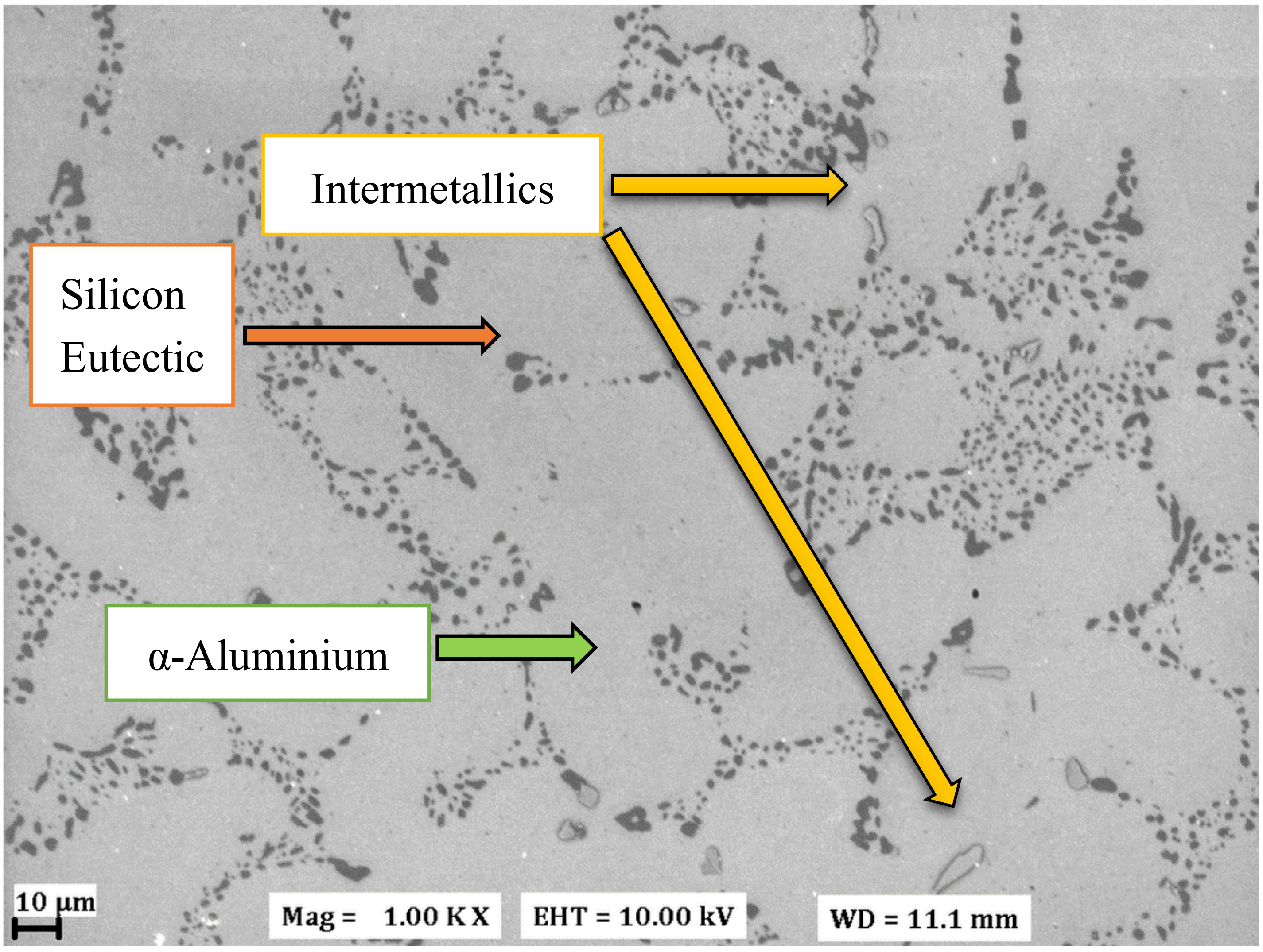
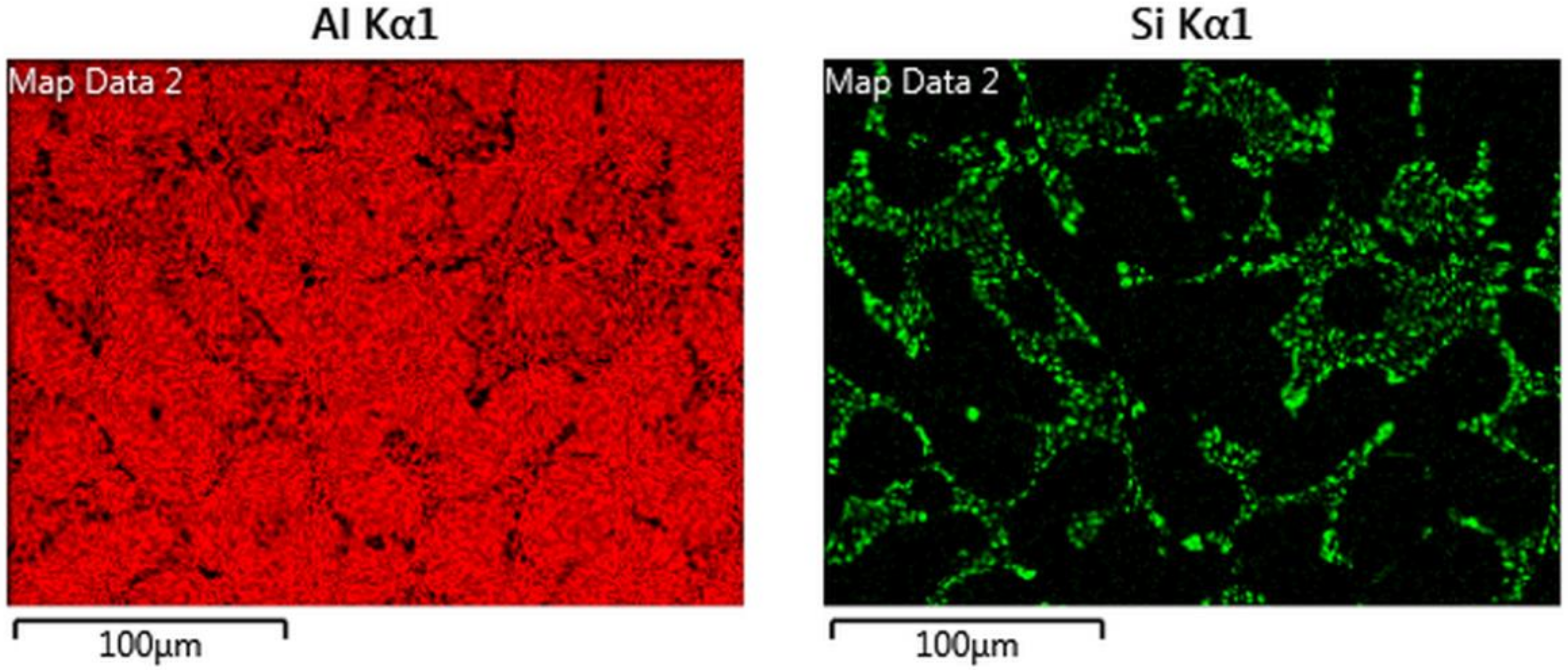
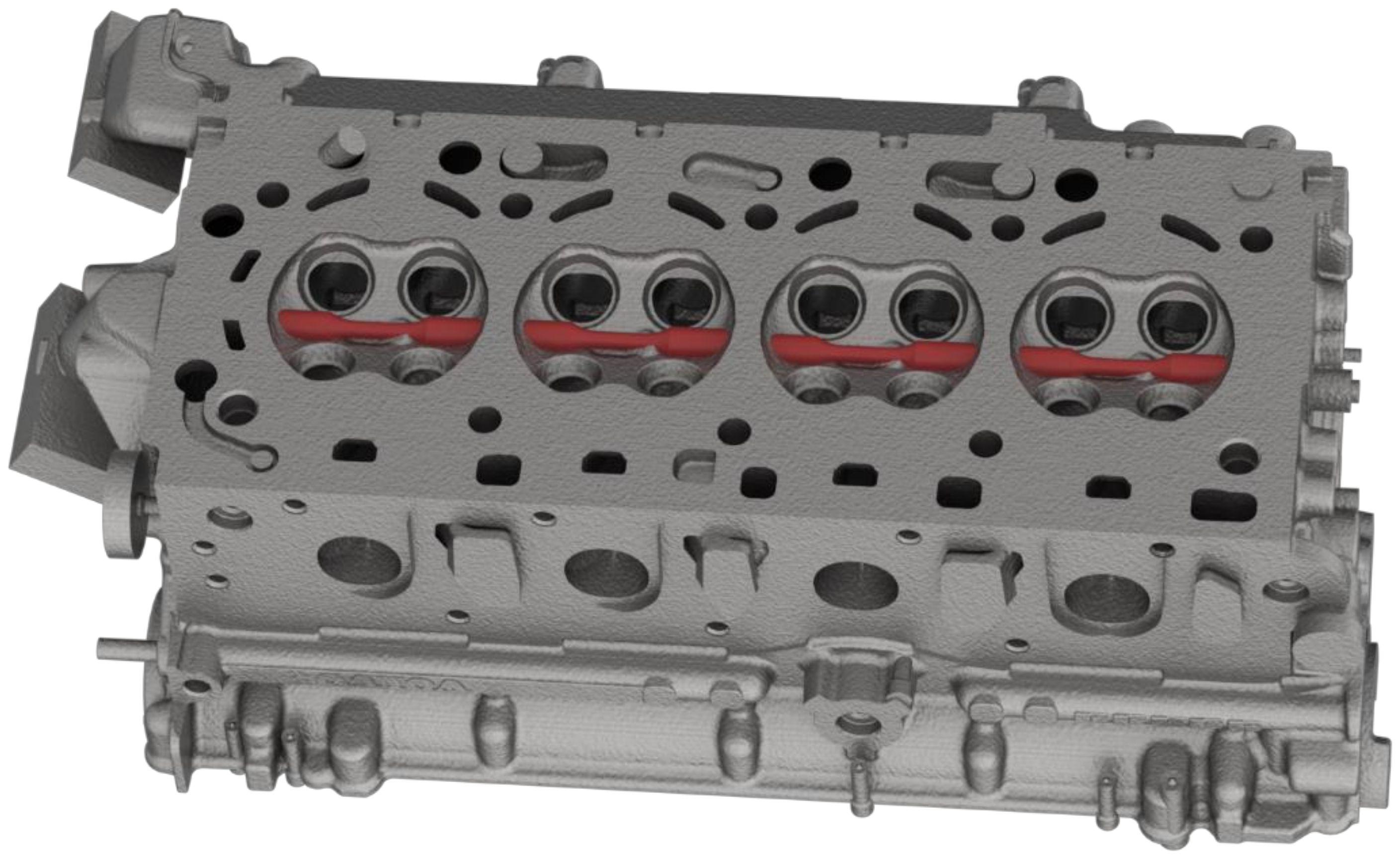
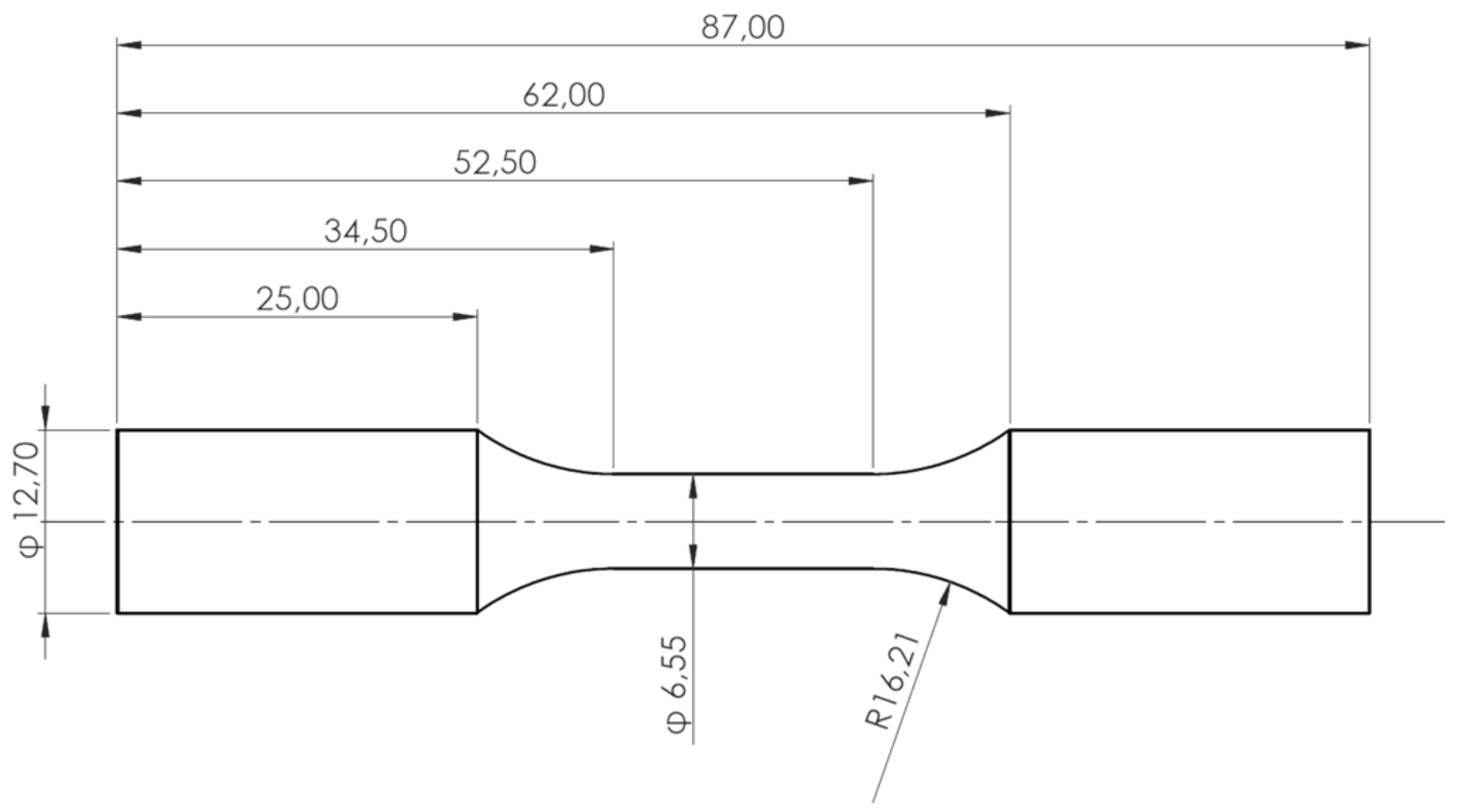

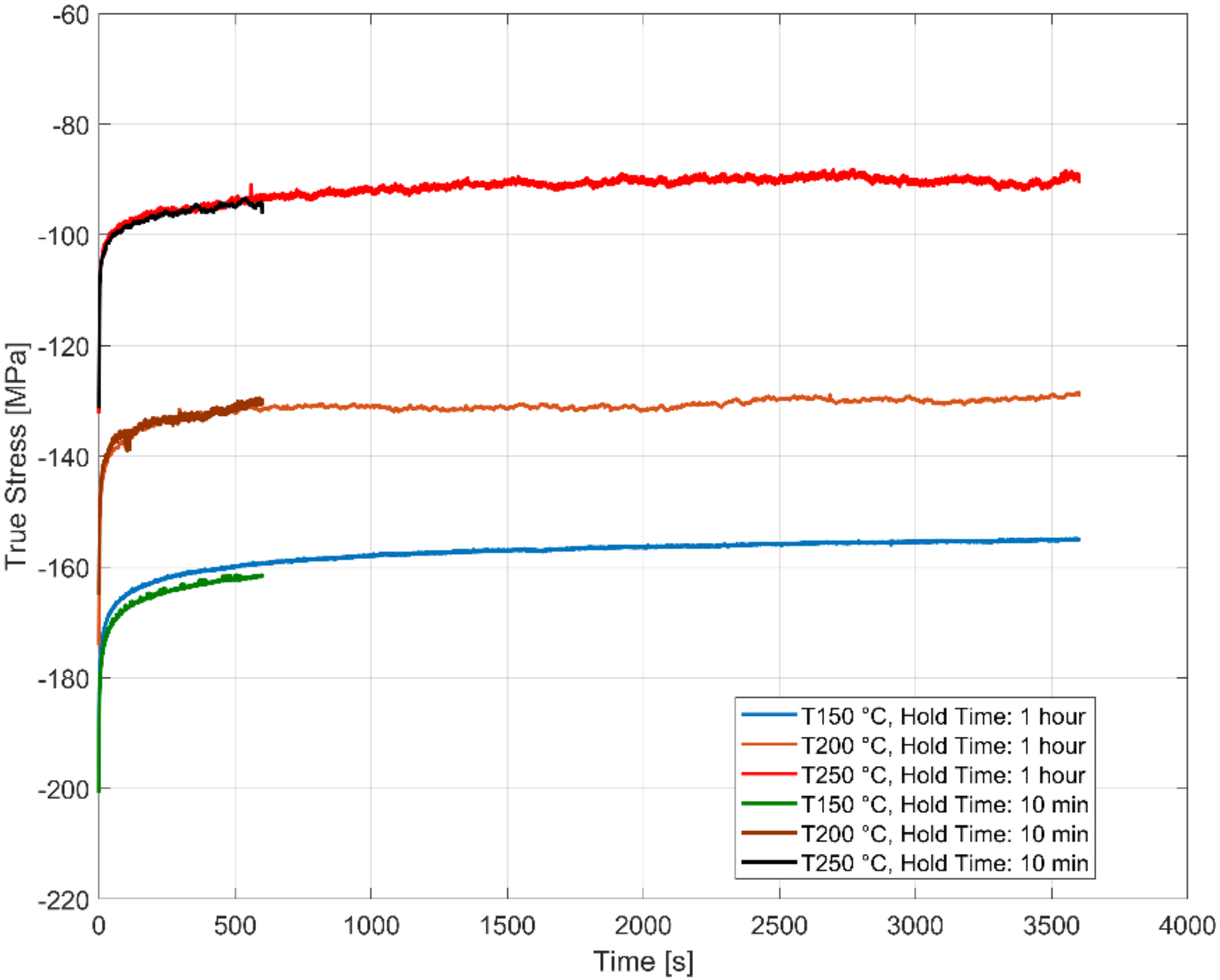
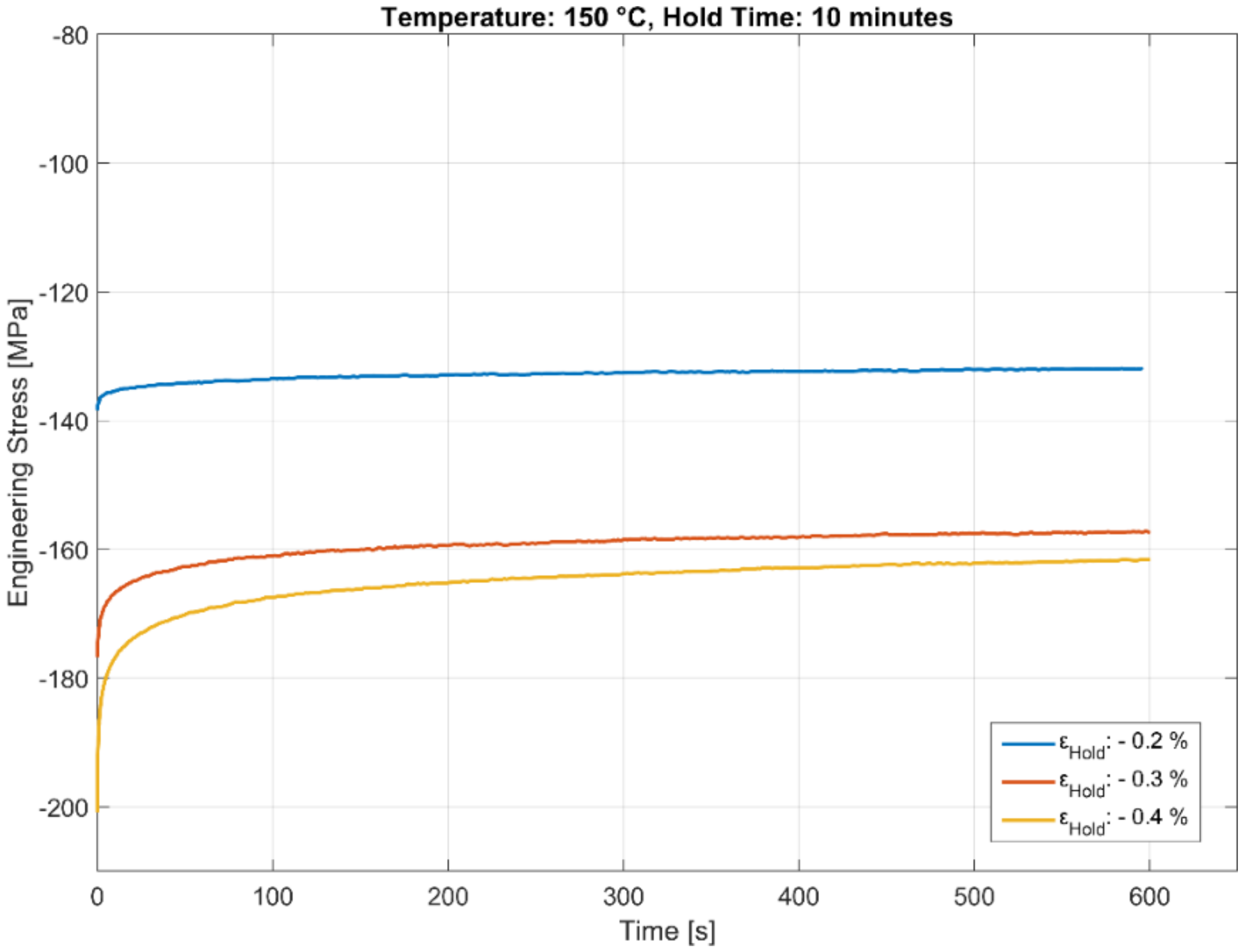

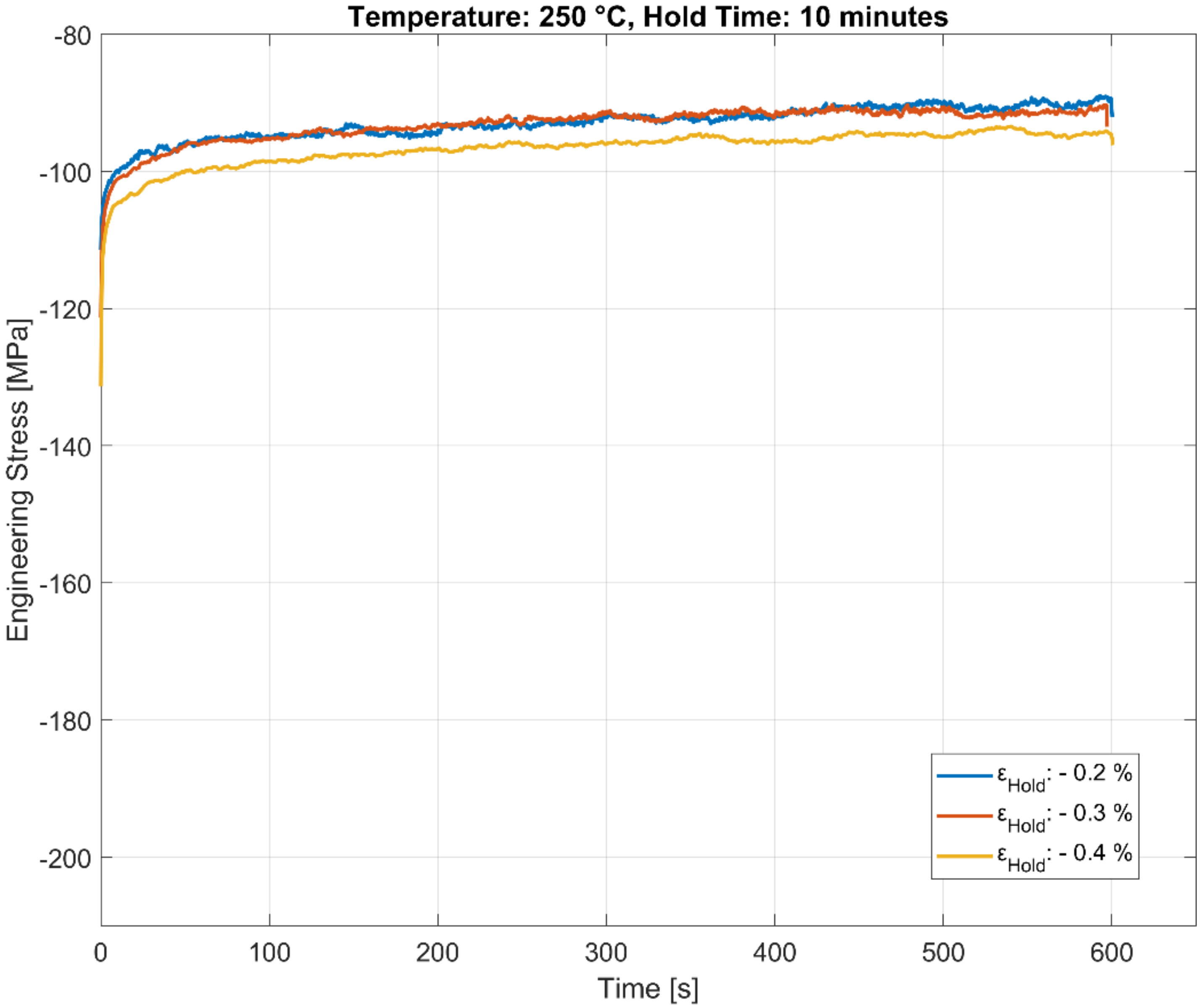
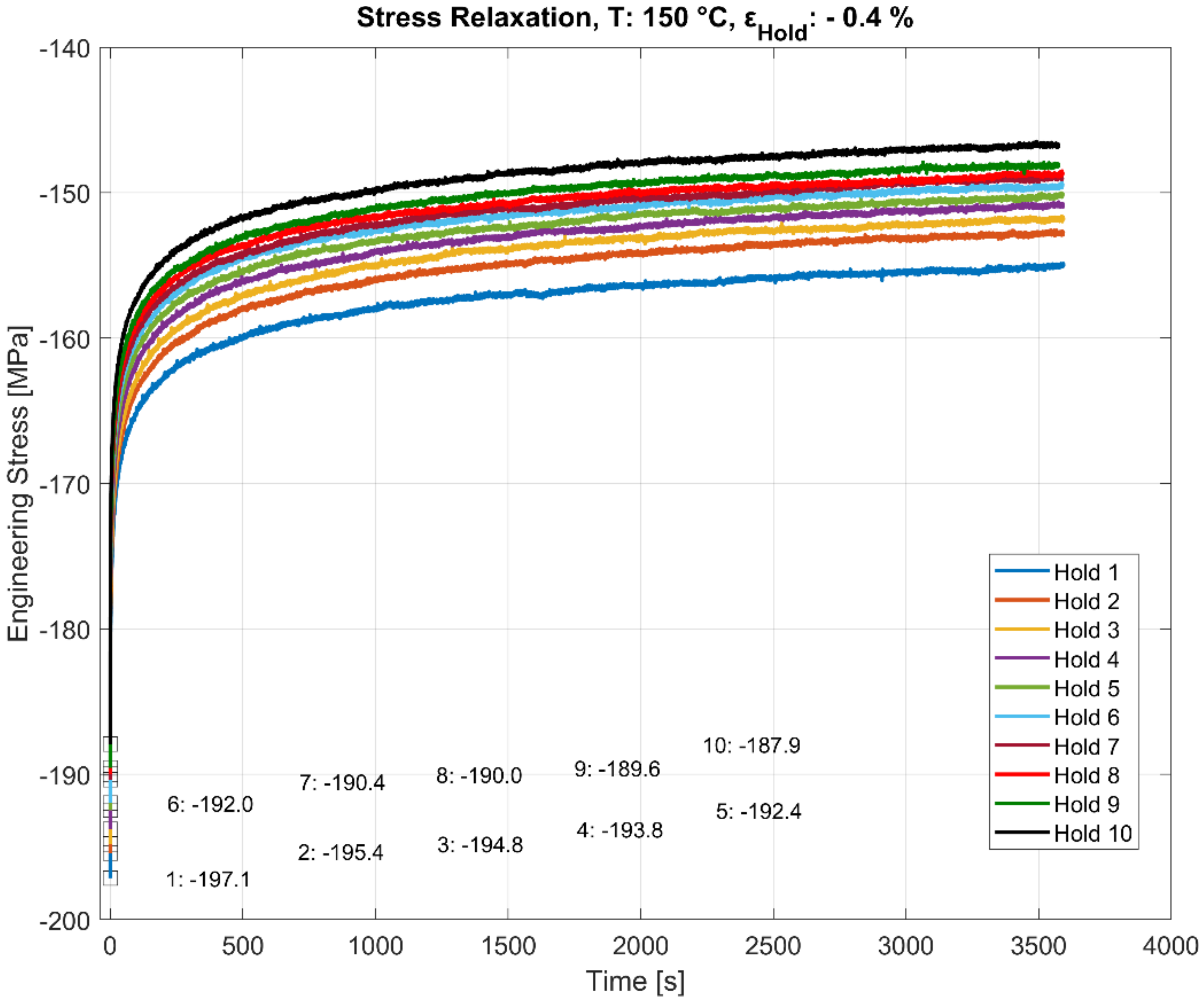
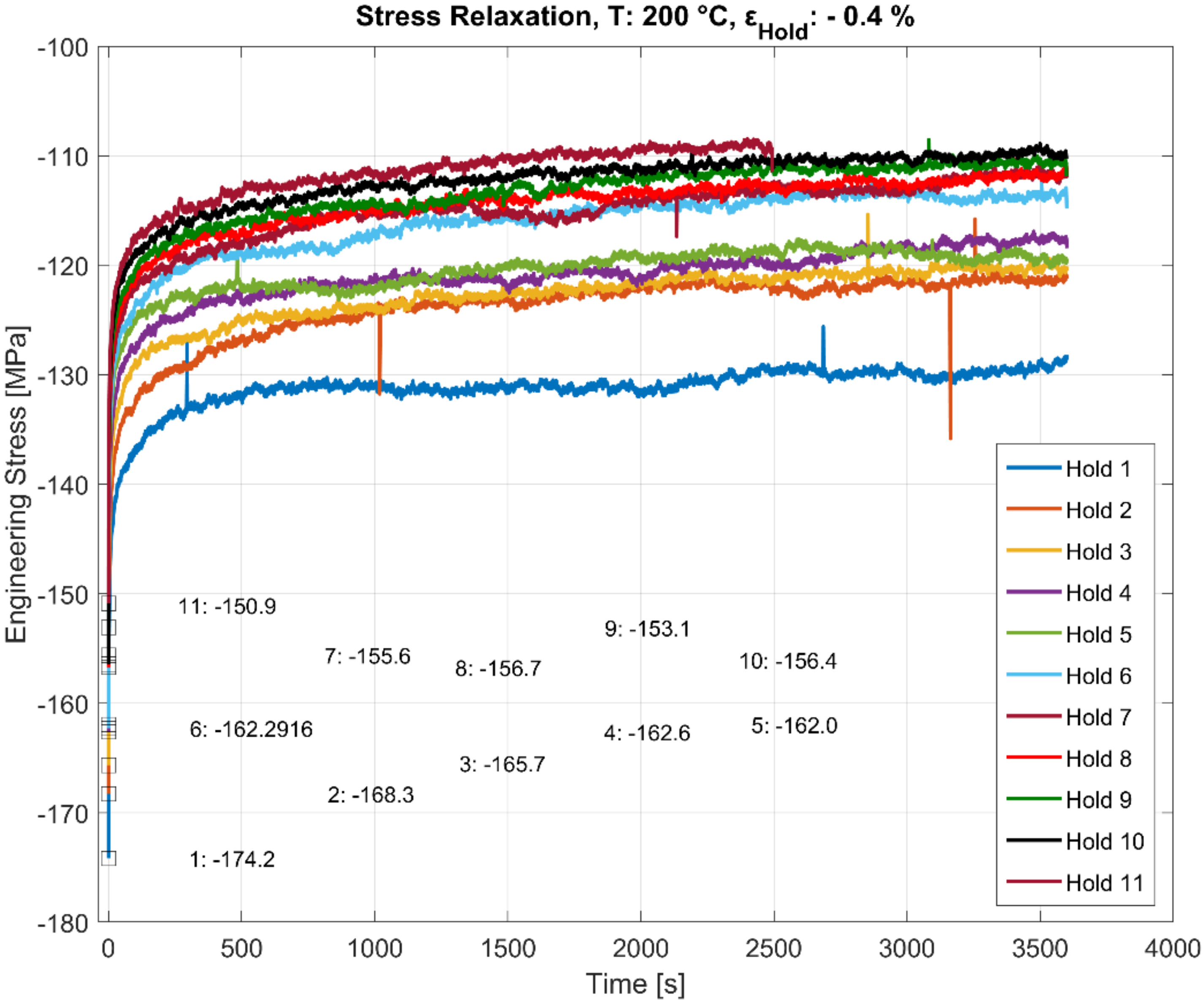
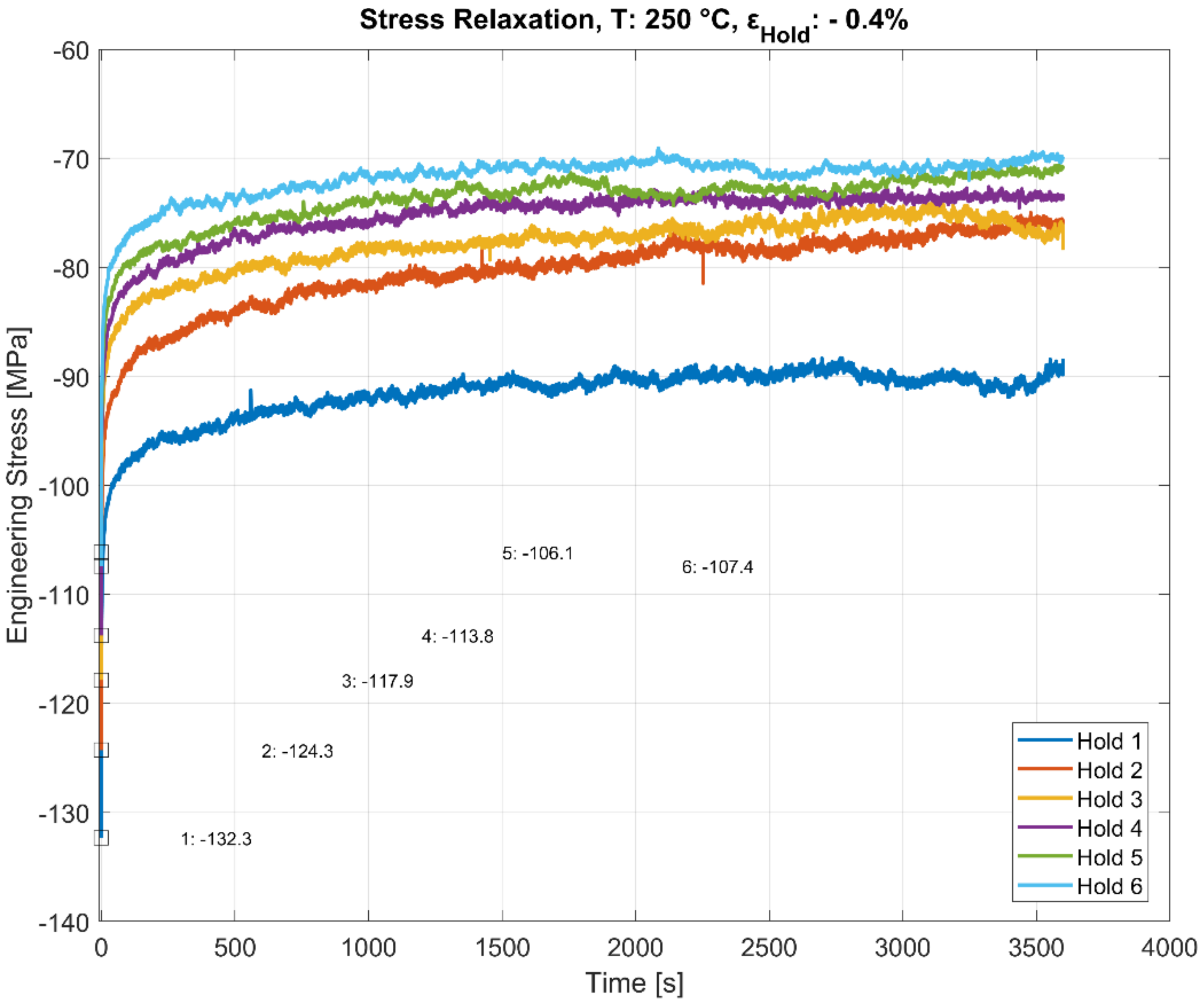
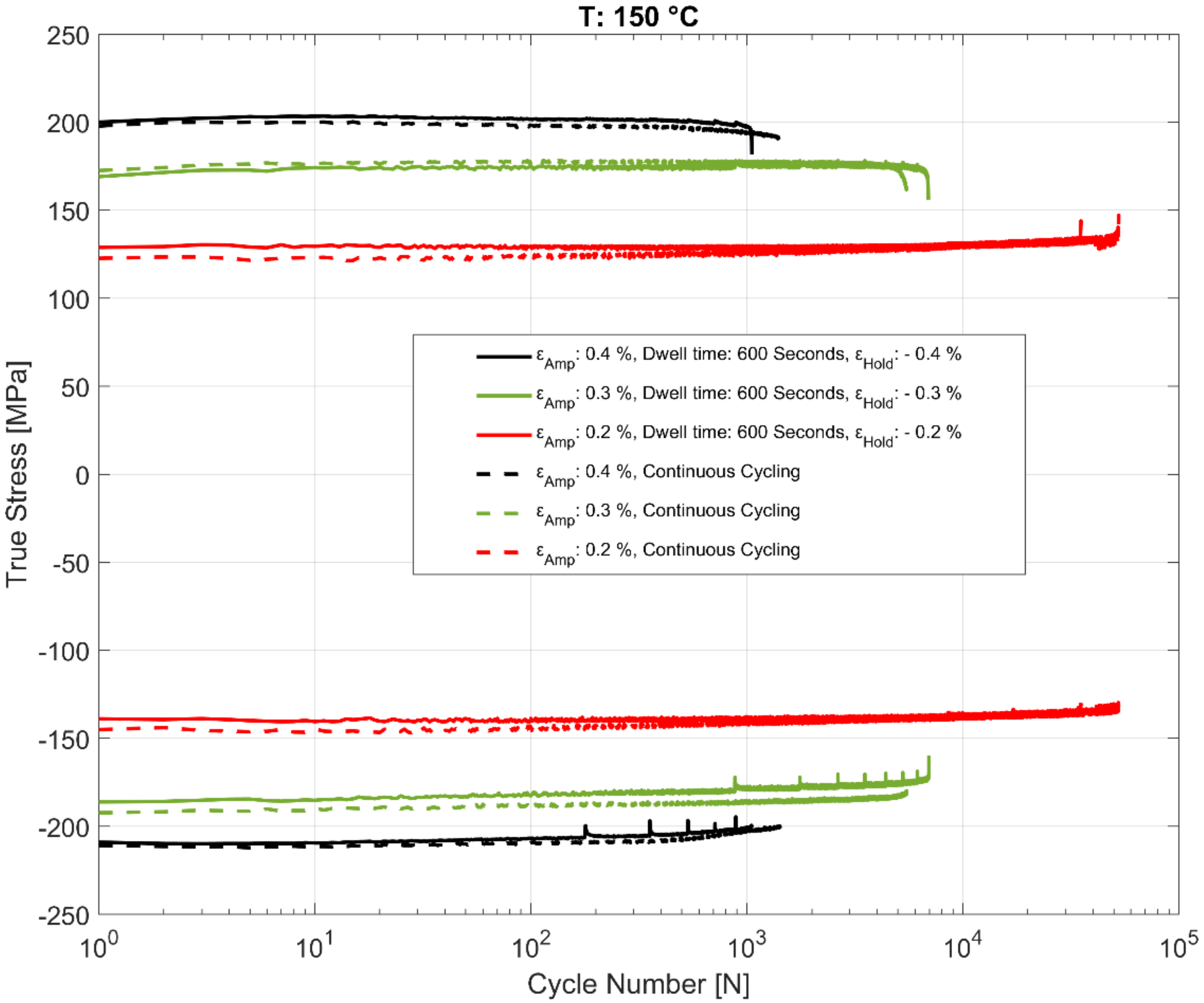
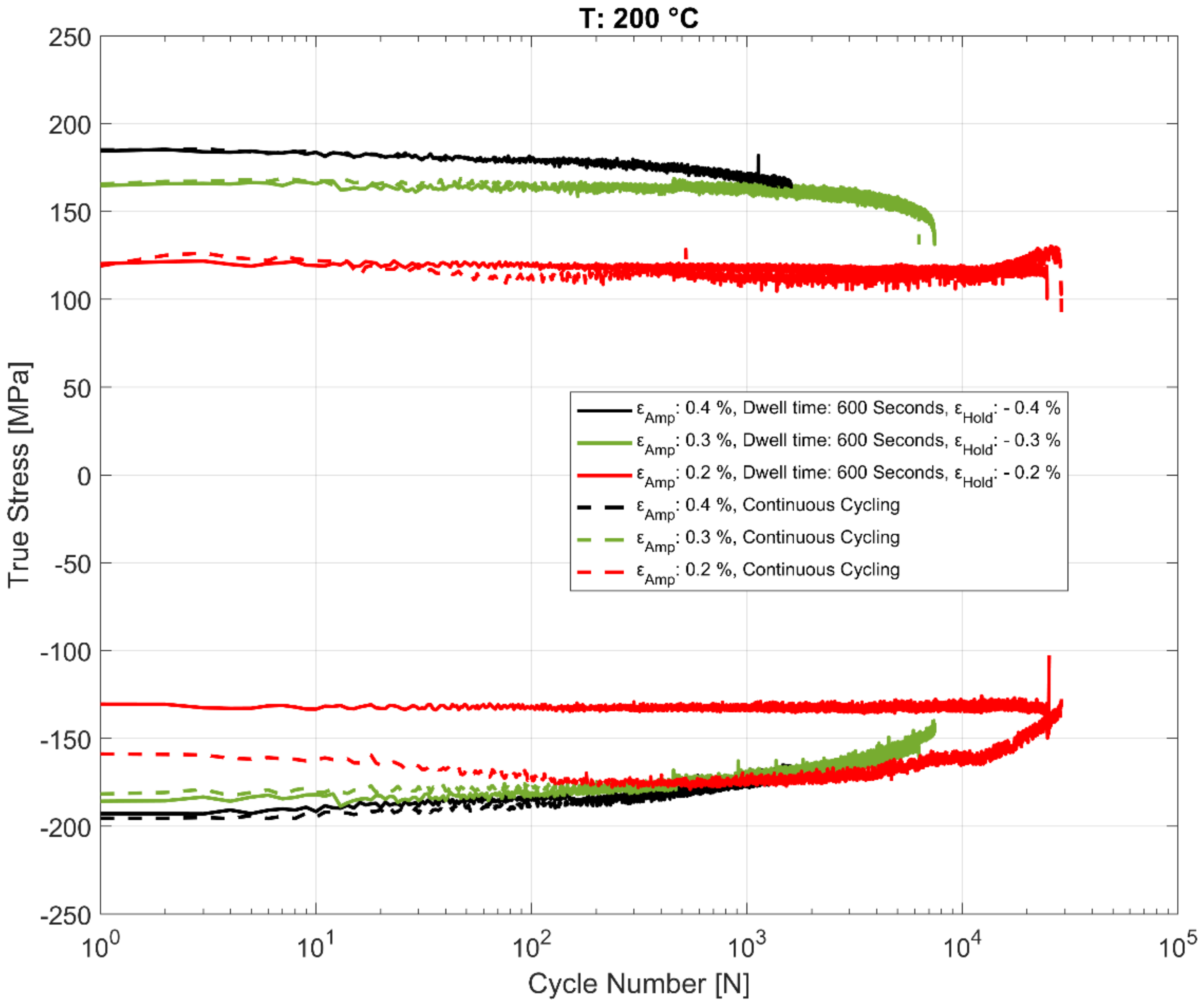
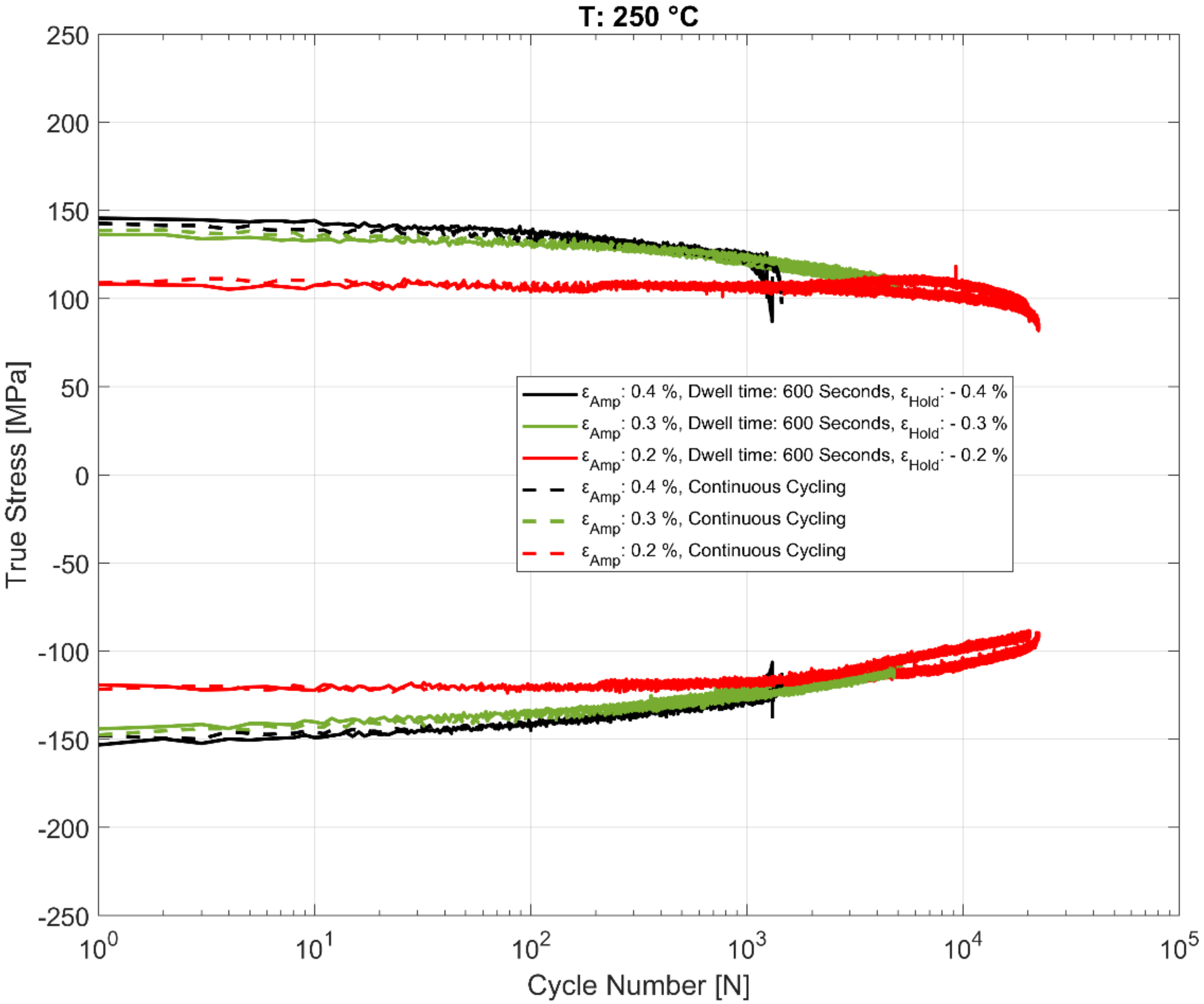
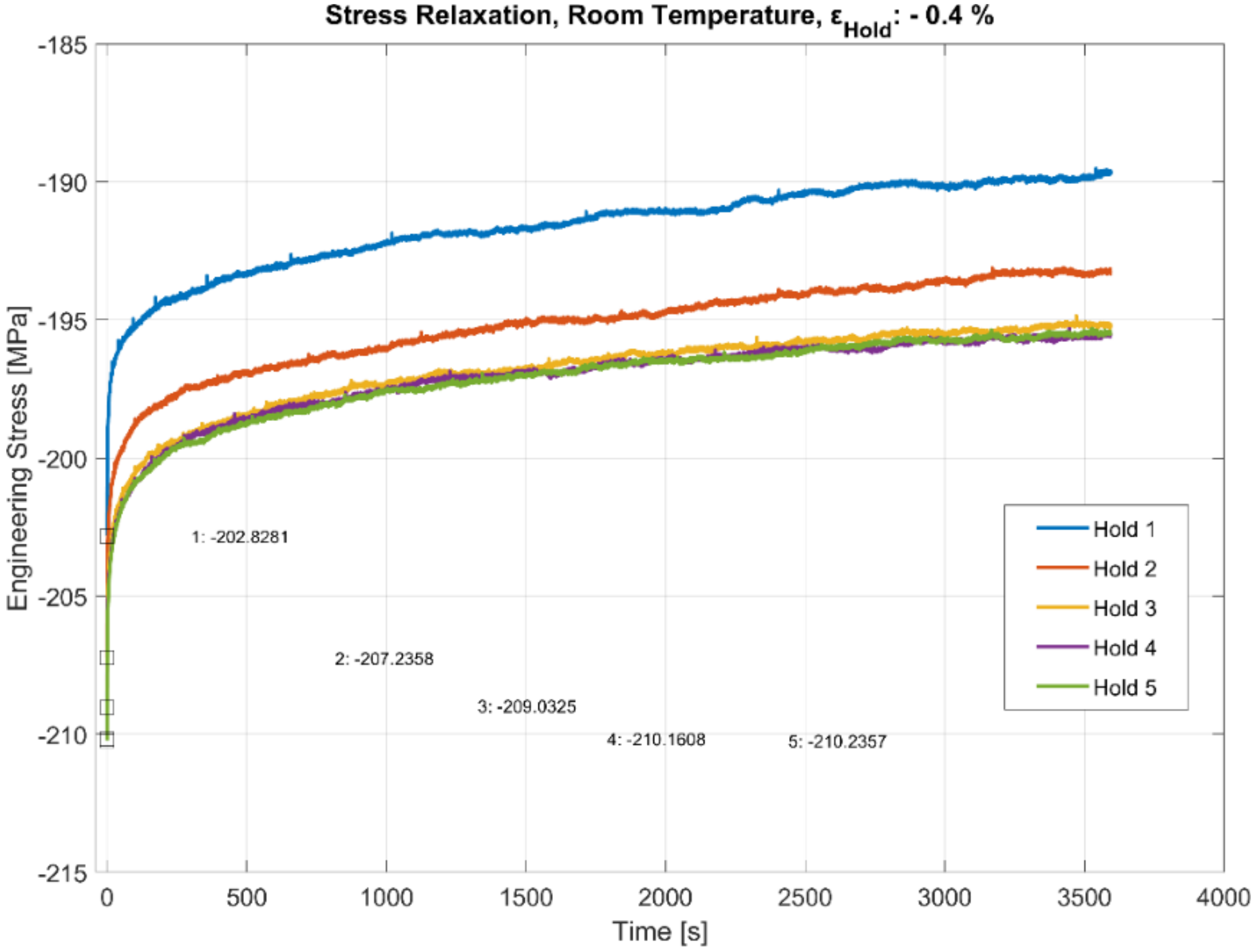
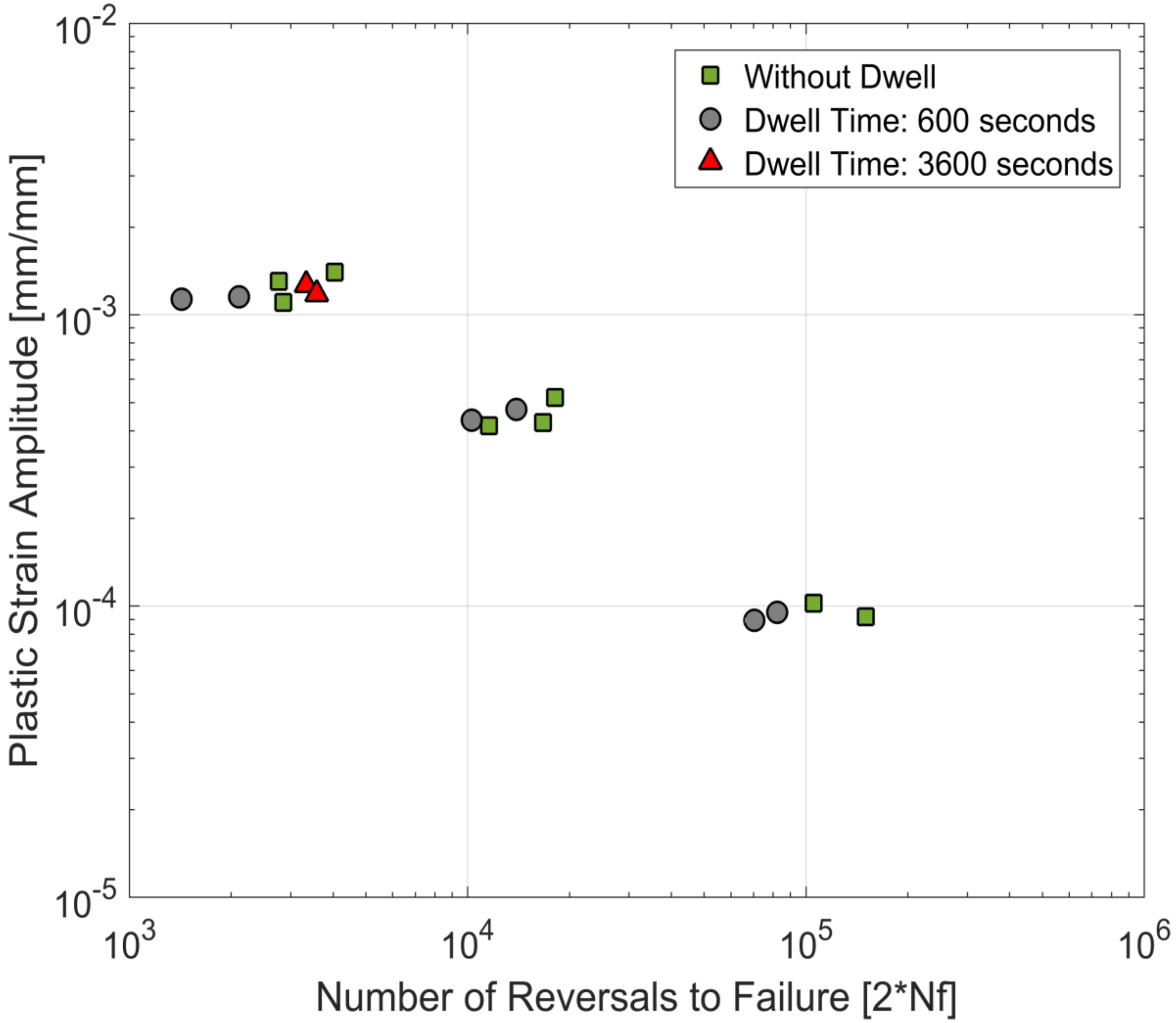


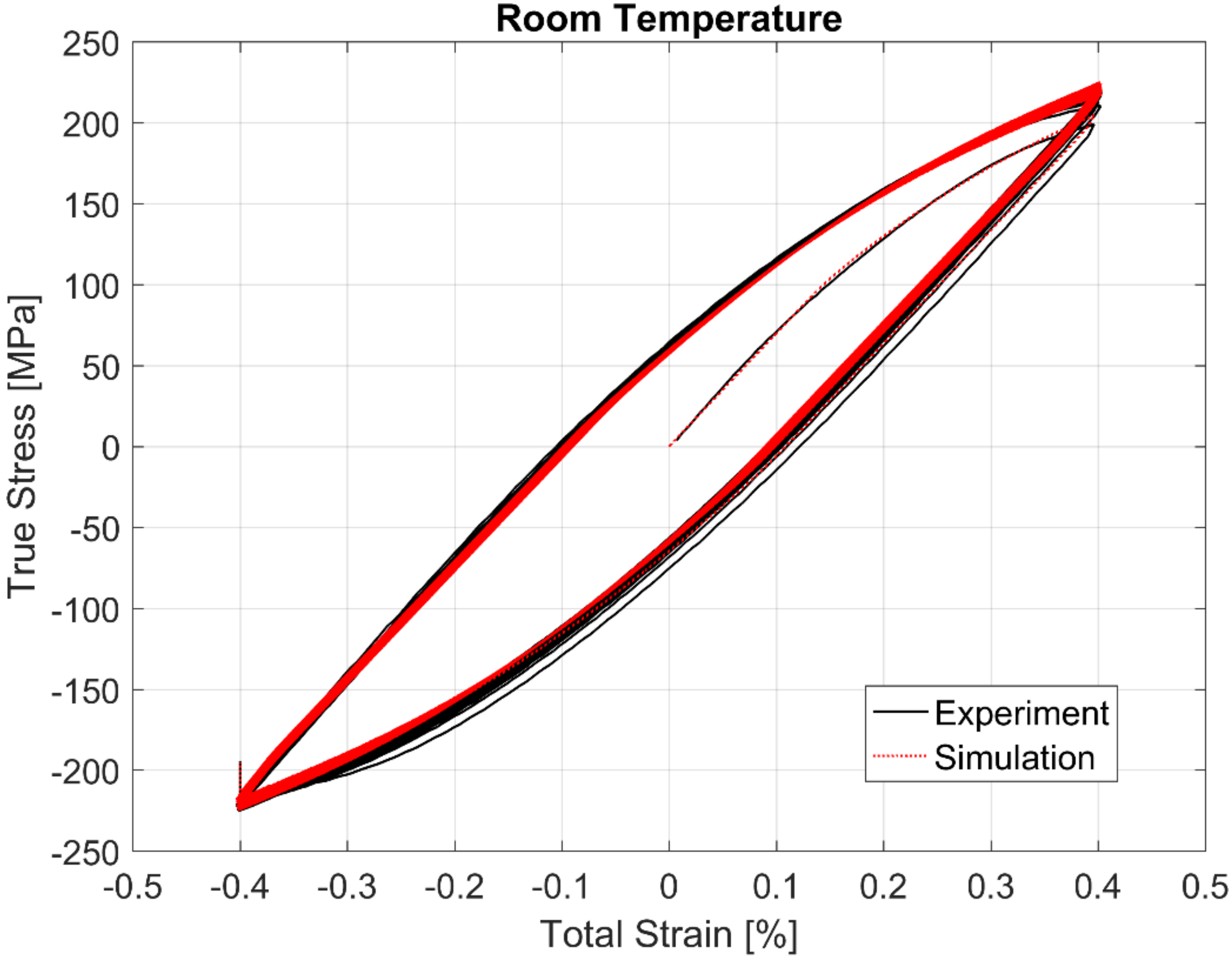

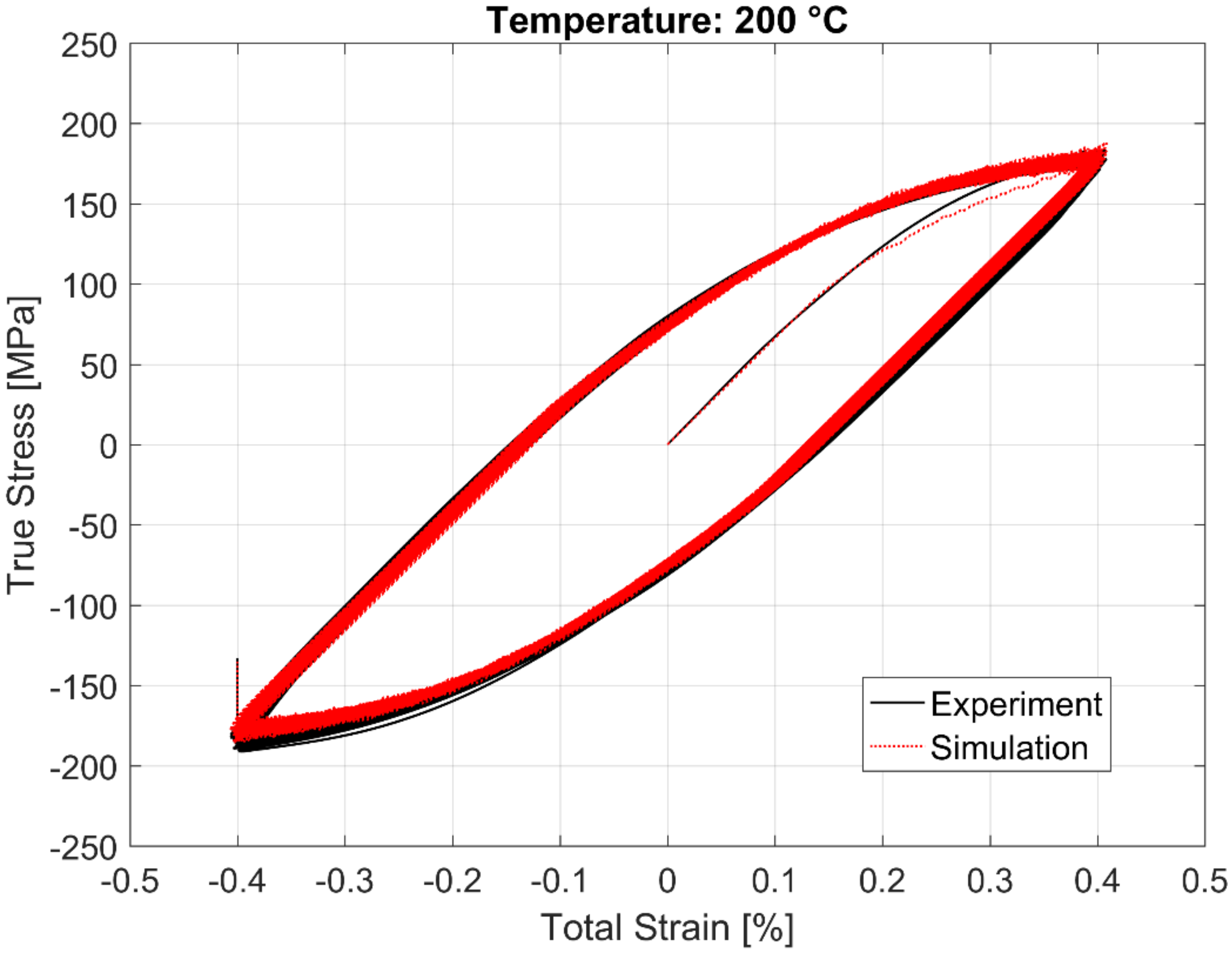


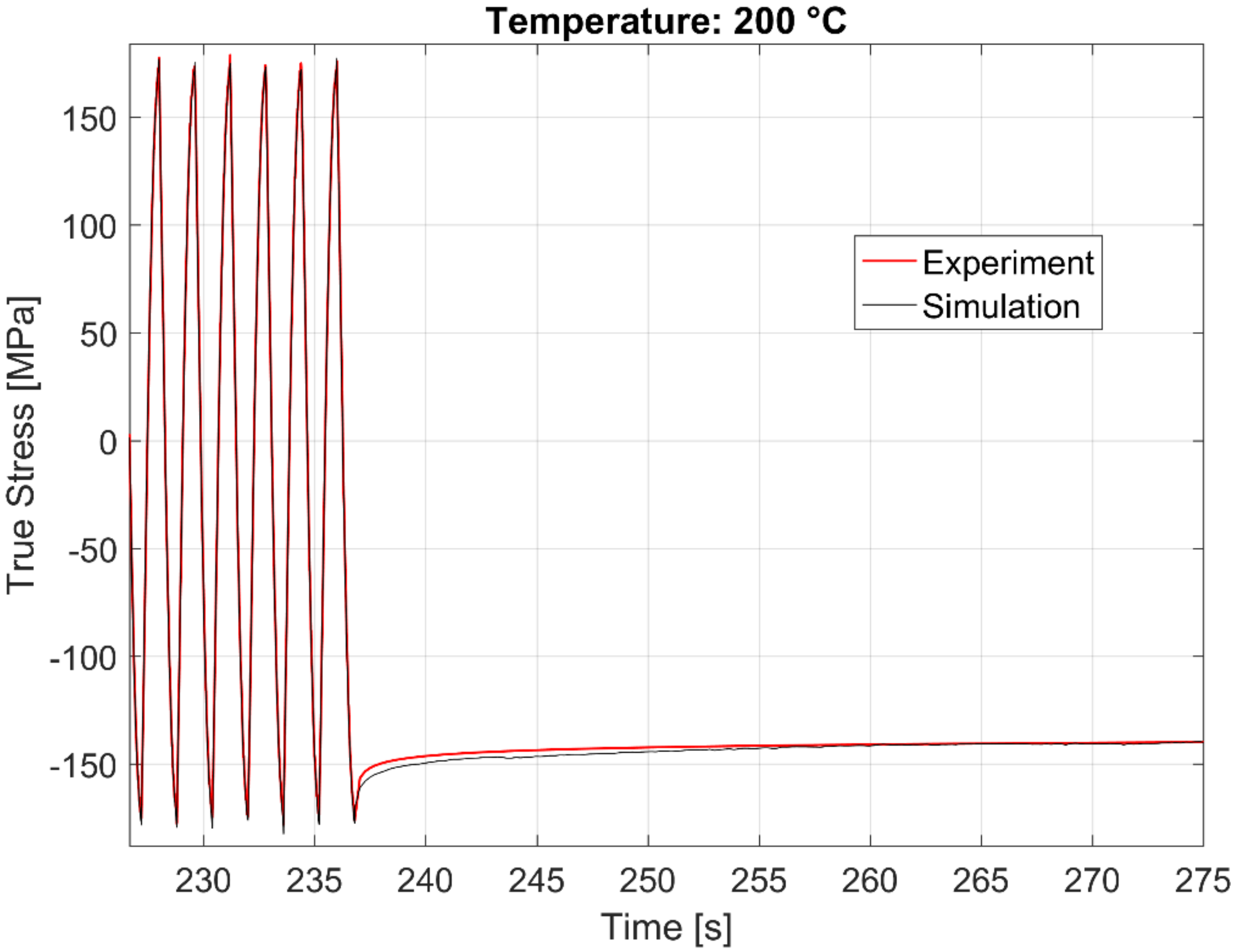
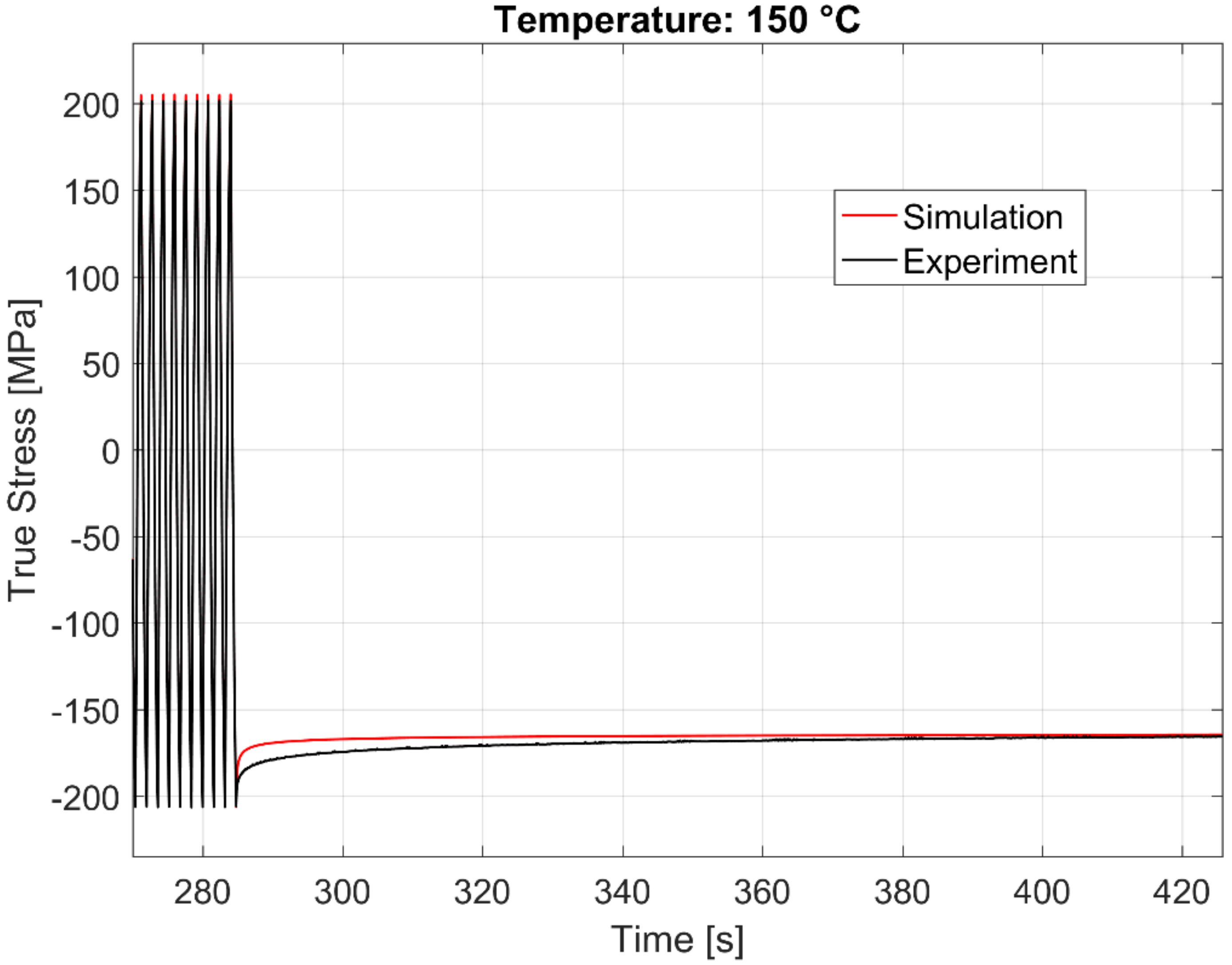

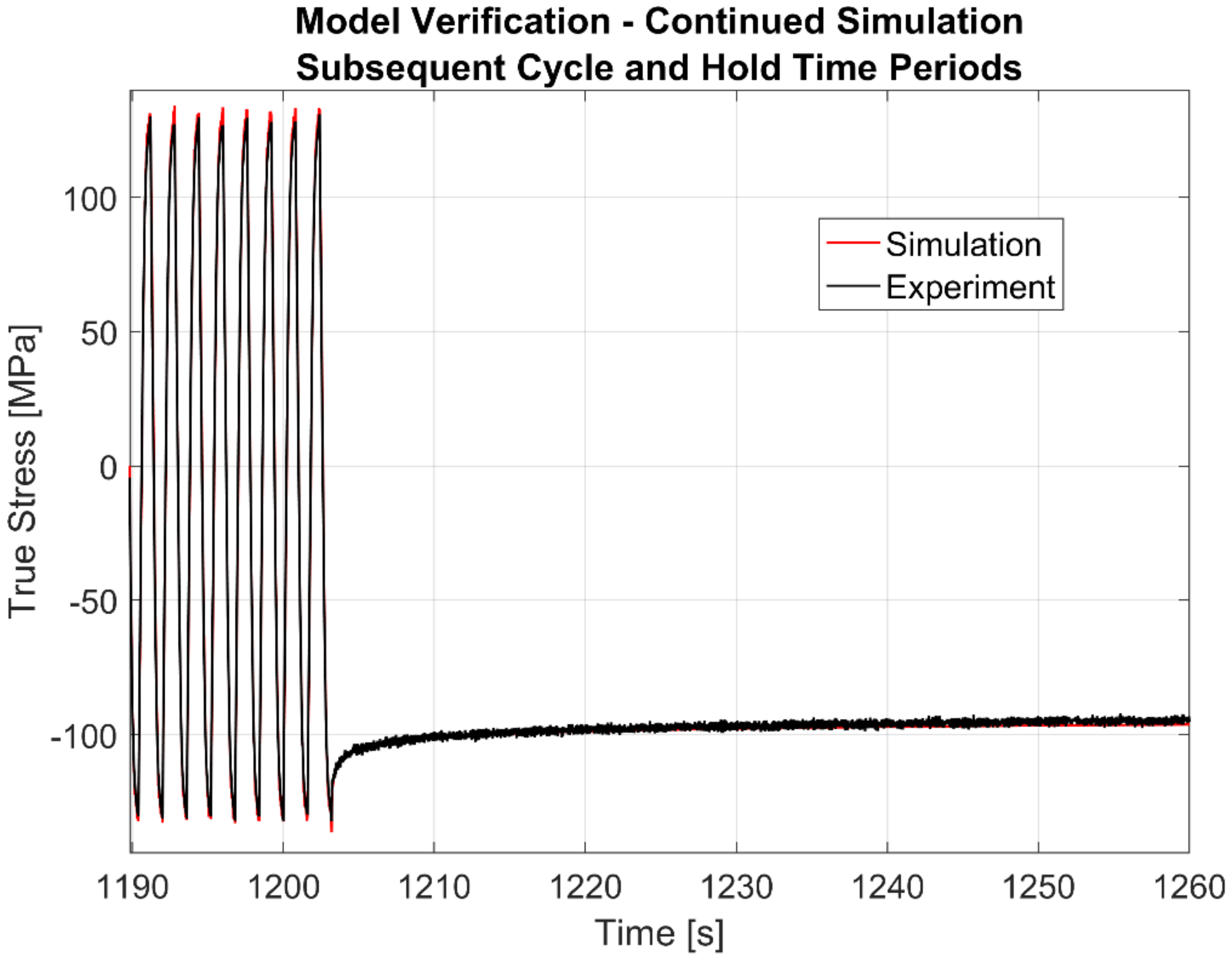
| Si | Cu | Mg | Ti | Fe | Mn | B | Others | Al |
|---|---|---|---|---|---|---|---|---|
| 6.8 | 0.53 | 0.35 | 0.12 | 0.10 | 0.07 | 0.0012 | <0.05 | Bal |
| Test Series | Test Temperatures | Load Levels | Replicas |
|---|---|---|---|
| Series A: Strain controlled tests with a hold time of 600 s | 150, 200, and 250 °C | Total Strain Amplitudes εTotAmp: 0.2%, 0.3%, and 0.4% Strain Ratio: Rε = −1 | 2 at each load-temperature combination |
| Series B: Strain controlled tests with a hold time of 3600 s | RT, 150, 200, and 250 °C | Total Strain Amplitude εTotAmp: 0.4% Strain Ratio: Rε = −1 | 2 at each temperature |
| Extensometer | Temperature |
|---|---|
| Instron 2620-603 axial clip-on dynamic extensometer (Instron, Norwood, MA, USA) | RT & 150 °C |
| Epsilon 3555-010M-020 high temperature 146 axial capacitive extensometer (Epsilon Technology Corporation, Jackson, WY, USA). | 200 & 250 °C |
| Temperature °C | Young’s Modulus [GPa] | Yield [Mpa] | Kinematic Hardening Parameter [Mpa] | [-] | Kinematic Hardening Parameter [MPa] | [-] | [MPa] | Hardening Parameter [-] | Multiplier [-] | Exponent [-] |
|---|---|---|---|---|---|---|---|---|---|---|
| RT | 69.85 | 90.00 | 156,178 | 3266 | 41,437 | 0 | 17 | 0.6141 | 0.0179 | 1.4422 |
| 150 | 69.55 | 64.65 | 154,190 | 2519 | 22,216 | 0 | −1.5 | 0.4601 | 0.0118 | 3.8595 |
| 200 | 66.33 | 54.50 | 115,350 | 1869 | 7286 | 0 | −10 | 0.6161 | 0.0062 | 6.9943 |
| 250 | 60.97 | 41.79 | 80,620 | 2161 | 3492 | 0 | −40 | 0.0315 | 0.0018 | 6.9943 |
© 2020 by the authors. Licensee MDPI, Basel, Switzerland. This article is an open access article distributed under the terms and conditions of the Creative Commons Attribution (CC BY) license (http://creativecommons.org/licenses/by/4.0/).
Share and Cite
Natesan, E.; Meyer, K.A.; Eriksson, S.; Ahlström, J.; Persson, C. Effects of Dwell Time on the Deformation and Fatigue Behaviour of A356-T7 Cast Aluminium Alloys Used in High Specific Power IC Engine Cylinder Heads. Materials 2020, 13, 2727. https://doi.org/10.3390/ma13122727
Natesan E, Meyer KA, Eriksson S, Ahlström J, Persson C. Effects of Dwell Time on the Deformation and Fatigue Behaviour of A356-T7 Cast Aluminium Alloys Used in High Specific Power IC Engine Cylinder Heads. Materials. 2020; 13(12):2727. https://doi.org/10.3390/ma13122727
Chicago/Turabian StyleNatesan, Elanghovan, Knut Andreas Meyer, Stefan Eriksson, Johan Ahlström, and Christer Persson. 2020. "Effects of Dwell Time on the Deformation and Fatigue Behaviour of A356-T7 Cast Aluminium Alloys Used in High Specific Power IC Engine Cylinder Heads" Materials 13, no. 12: 2727. https://doi.org/10.3390/ma13122727
APA StyleNatesan, E., Meyer, K. A., Eriksson, S., Ahlström, J., & Persson, C. (2020). Effects of Dwell Time on the Deformation and Fatigue Behaviour of A356-T7 Cast Aluminium Alloys Used in High Specific Power IC Engine Cylinder Heads. Materials, 13(12), 2727. https://doi.org/10.3390/ma13122727





